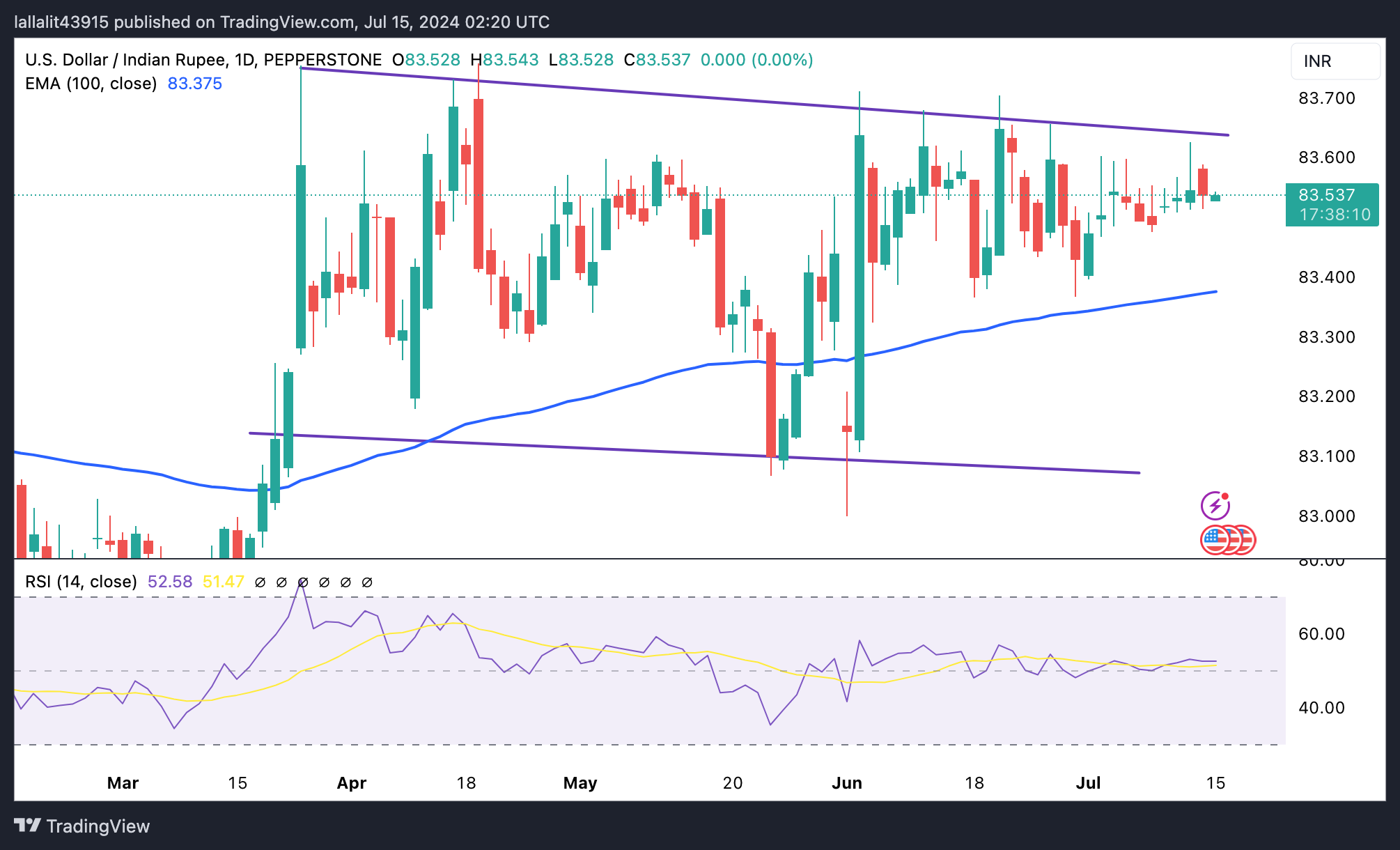- The Indian Rupee is trading sideways in the Asian session on Monday.
- Possible Fed rate cuts, lower US bond yields could support the local currency; a firmer USD could weigh on the INR.
- Traders are looking to India’s Wholesale Price Index (WPI) inflation data on Monday for fresh impetus.
The Indian Rupee (INR) is trading flat on Monday despite a recovery in the US Dollar (USD). Rising hopes for rate cuts by the Federal Reserve (Fed), lower US bond yields and persistent foreign capital inflows into India could boost the INR. However, extended gains in crude oil prices and renewed demand for the Dollar by state-owned banks and local importers limit the potential gains for the INR. The downside of the local currency could be limited amid routine interventions by the Reserve Bank of India (RBI), which could support the INR from depreciating to near multi-month lows.
Looking ahead, investors will be eyeing India’s Wholesale Price Index (WPI) inflation data on Monday, which is expected to rise to 3.50% year-on-year in June from 2.61% in May. India’s trade balance will also be released. On the US economic docket, the New York Fed’s Empire State Manufacturing Index for July will be released, while the Fed’s Mary Daly is scheduled to speak.
Daily Market Wrap: Indian Rupee trades flat despite stronger US Dollar
- India’s Consumer Price Index (CPI) rose to the highest level in four months at 5.08% year-on-year in June on the back of higher food prices, official data showed on Friday. This was above the market consensus and the previous reading of 4.80%.
- India’s industrial production rose 5.9% year-on-year in May from 5.0% in April, beating the estimate of 4.9%.
- The US Producer Price Index (PPI) rose to 2.6% YoY in June from an upwardly revised previous reading of 2.4%, above the consensus of 2.3%. The core PPI rose 3.0% YoY, beating the 2.5% expected. On a monthly basis, the PPI rose 0.2% MoM in June, above the market consensus of 0.1%.
- The University of Michigan Consumer Sentiment Index survey fell to 66.0 in July from 68.2 in June, the lowest level in seven months, falling short of the expected rise to 68.5. The University of Michigan 5-year consumer inflation expectations declined slightly in July to 2.9% from the previous reading of 3.0%.
- Financial markets are now pricing in a more than 90% chance of a 25 basis point (bps) cut in September, according to the CME Fedwatch tool.
Technical Analysis: USD/INR remains in consolidation mode in the short term
The Indian Rupee is trading flat on the day. The USD/INR pair remains bullish on the daily chart as it holds above the key 100-day exponential moving average (EMA).
However, in the short term, the pair has remained within its one-month range since March 21. The 14-day Relative Strength Index (RSI) is hovering around the midline of 50, suggesting that further consolidation cannot be ruled out.
A decisive break above the upper limit of the trading range at 83.65 could pave the way towards the all-time high of 83.75. Further north, the next bullish barrier will emerge at the psychological level of 84.00.
On the other hand, a break of the 100-day EMA at 83.37 could drag the pair lower to the round figure of 83.00. Sustained trading below this level will expose 82.82, a low of January 12.
US Dollar Price Today
The table below shows the percentage change of the US Dollar (USD) against the major currencies listed today. The US Dollar was the strongest against the New Zealand Dollar.
| USD | EUR | GBP | CAD | AUD | JPY | NZD | CHF | |
| USD | -0.02% | 0.01% | 0.03% | 0.00% | -0.13% | 0.06% | -0.10% | |
| EUR | 0.01% | 0.02% | 0.05% | 0.02% | -0.12% | 0.07% | -0.09% | |
| GBP | -0.02% | -0.03% | 0.02% | -0.01% | -0.13% | 0.03% | -0.12% | |
| CAD | -0.05% | -0.05% | -0.03% | -0.04% | -0.16% | -0.01% | -0.15% | |
| AUD | 0.00% | -0.02% | 0.00% | 0.03% | -0.15% | 0.05% | -0.12% | |
| JPY | 0.15% | 0.15% | 0.16% | 0.21% | 0.15% | 0.15% | 0.04% | |
| NZD | -0.04% | -0.07% | -0.05% | -0.02% | -0.06% | -0.16% | -0.16% | |
| CHF | 0.10% | 0.08% | 0.11% | 0.13% | 0.13% | -0.02% | 0.13% |
The heatmap shows the percentage changes of the major currencies relative to each other. The base currency is chosen from the left column, while the quote currency is chosen from the top row. For example, if you choose the Euro from the left column and move along the horizontal line to the Japanese Yen, the percentage change shown in the chart will represent EUR (base)/JPY (quote).
Source: Fx Street
I am Joshua Winder, a senior-level journalist and editor at World Stock Market. I specialize in covering news related to the stock market and economic trends. With more than 8 years of experience in this field, I have become an expert in financial reporting.








